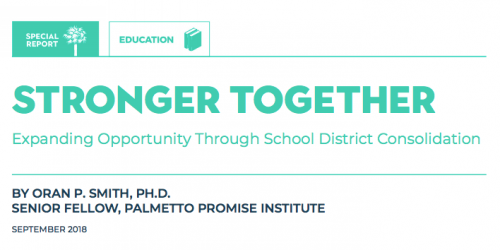Stronger Together: Expanding Opportunity Through School District Consolidation
During the 2017-2018 legislative session, an old proposal became new again: the idea of merging several of South Carolina’s smaller school districts together with neighboring districts to form larger ones. This short paper seeks to gather facts, statistics, and previous comprehensive studies on the issue to find answers to the question “Should some South Carolina school districts be consolidated with others?”
KEY TAKEAWAYS FROM THIS REPORT
- South Carolina has moved beyond its historical “fend for yourself” localism of the Tillman Era (p.5 in the report) with seminal legislation like the Education Finance Act (p.6), but education funding is a partnership. If the state is to continue to invest heavily in public education, local authorities must meet their fiduciary responsibilities as well.
- An openness to consolidation of school districts is a part of that fiduciary responsibility. Consolidation is supported by common sense (p.17), academic studies (p. 22), consultant analysis (p.26) and the experience of the states to which we aspire (p.25).
- Districts that are small (p.12) or shrinking (p.13) or both (p.15) are simply not cost-effective. Even some larger, wealthier counties with districts that are moderate in size could benefit financially from consolidation (p.26).
- Piecemeal solutions of the past that are alternatives to full consolidation have been expensive and ineffective.
- Each multi-district county is unique (p.18-21). But all can achieve some consolidation in a manner appropriate for that county. With consolidation, parents and communities can build relationships across existing district lines that will provide more diversity and capacity as well as more effective leadership—that’s the formula for educational success. Consolidation among neighboring districts will not destroy communities, but build them. Working together as one region will allow communities with shallower tax bases to share the financial burden for world-class schools that prepare students to meet the challenges of the ambitious Profile of the South Carolina Graduate.
- Consolidation is not a panacea. Accompanying redesigns and reforms, such as school finance reform that returns to the principles of the Education Finance Act (EFA) and addresses assessment variation, will be necessary (p.3,28).
- Districts that are both shrinking and small are ripe for consolidation and serve as a place to begin our efforts as a state (p.15).
- Orangeburg County legislators and school leaders (as well as those of Sumter, Dillon and Marion Counties shortly before) have shown the way for how consolidation can be accomplished, reaching across race, party, and community to resist myopia and put children first (p.30).
- The next legislative session (2019-2020) with a newly-elected governor, is the time to make consolidation a reality, but conversations must begin now (Fall 2018) and county legislative delegations must step up with courage.
- Funds saved through consolidation should be reinvested into the classroom, not administration. Classrooms and schools are the units of change, not district offices.
Compared to other states, South Carolina is relatively poor economically, ranking in the 40s out of 50 states in median household income. That means every dollar of the nearly $9 billion spent by state, local and federal government on education in South Carolina should be invested wisely. There is little margin for error. To not consolidate districts is to pick the pockets of the children (and teachers) of South Carolina.
Chester Finn of the Thomas B. Fordham Institute put it best when he said of Arkansas that their goal in consolidation was to: “introduce administrative efficiencies without endangering the quality of the educational experience that can be realized in an intimate setting surrounded by a supportive community.”
It is time.






